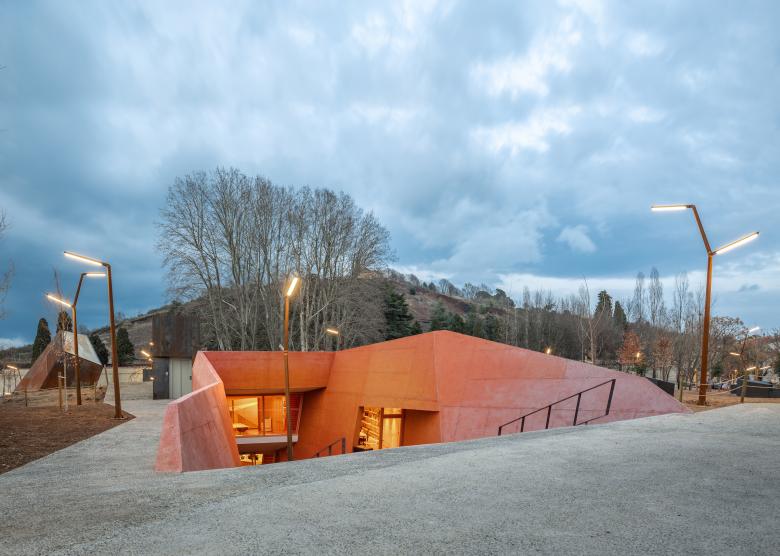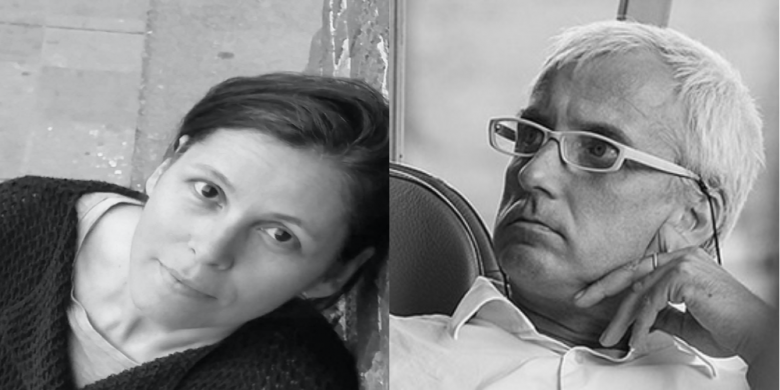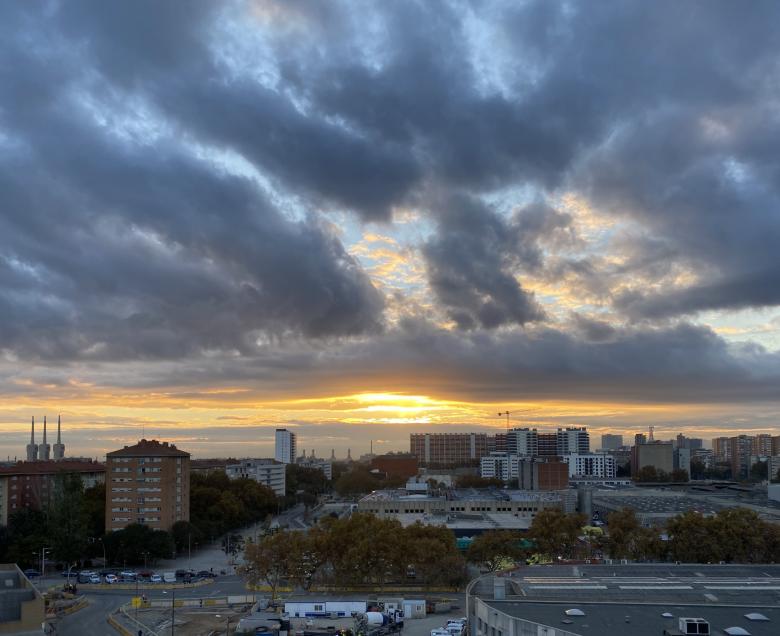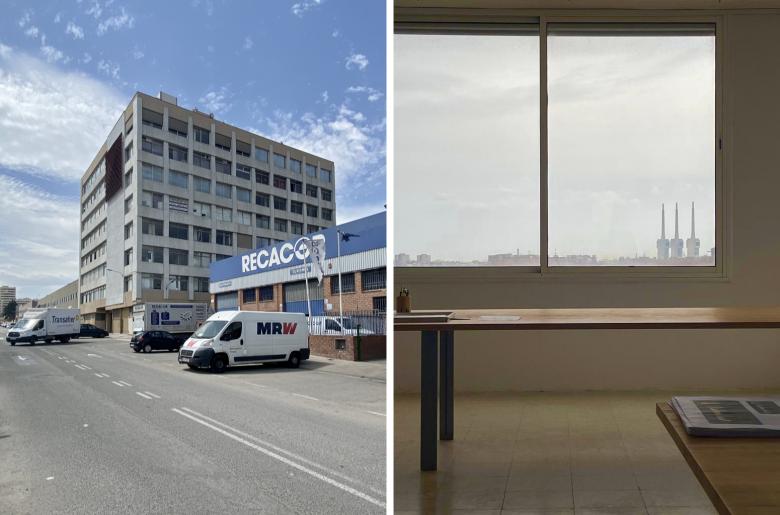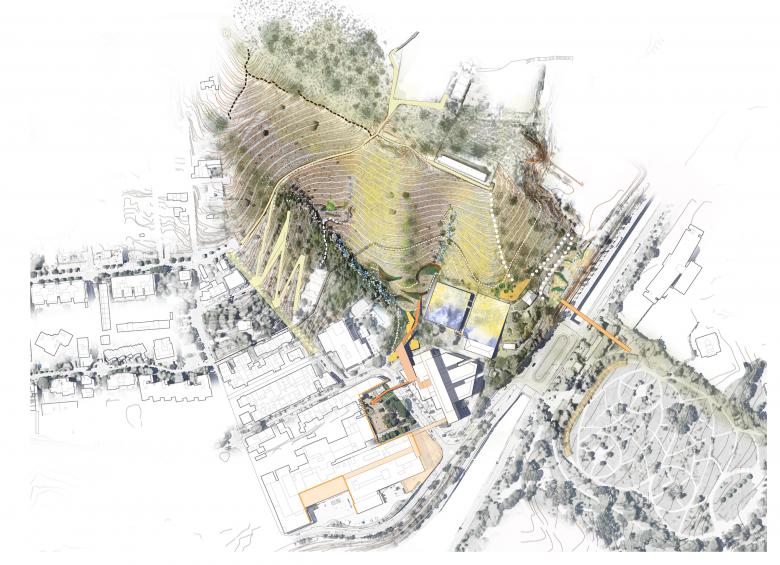A conversation with Anna Codina and Toni Casamor
VOL: At Home on the Edge of the City
Madeline Beach Carey
26. May 2023
Espai Cràter, Museum of Volcanoes in Olot, Spain, 2021 (Photo: Marc Torra)
In 2019, after more twenty years living together, Toni Casamor and Anna Codina, two well-known, experienced architects in Catalonia, started working together. Codina and Casamor had worked at their own offices for many years. Each had taught, won competitions and awards, and practiced separately. Then, in the middle of their lives, in the middle of their careers, the couple made a change, a turn; together they created VOLstudio.
L-R: Anna Codina and Toni Casamor
Recently, I made the journey from the center of Barcelona out to see VOLstudio’s new shared studio. In our city — tiny in geographic terms, densely populated — having to make such a trip isn’t the most habitual: Architects, designers, and other cool cultural types tend to stay close to one another, in the city center; or perhaps, over in Poble Nou in the 22@ district, an urban regeneration district financed and planned by the City Hall.
I could have taken the metro to VOLstudio, but I was in a rush and decided to take a cab. The ride however turned out to be long and slow. The driver wasn’t sure we were on the right track, but he and I both decided to trust the GPS. Even upon arrival I wasn’t fully convinced I had reached the right place. The industrial building on Via Trajana seemed abandoned; it reminded me of some sort of art-house performance space in 1970s New York. The looming cargo elevator was, well, a bit scary, but my confusion and initial apprehension were unfounded: On the seventh floor my hosts — and a spectacular view of Barcelona — awaited.
The spectacular view of Barcelona from VOLstudio's office
Codina and Casamor began working here together, in the La Verneda i La Pau neighborhood, just before the pandemic. The space — on the industrial outskirts close to the border with Sant Adrià — represents a turn in their personal and professional lives: Vol means flight in Catalan. This new, raw space on the outskirts of town is a place from which to build with freedom, risk. Still, the feeling one has upon entering the space of VOLstudio is almost domestic. It doesn’t feel like an industrial space or a shiny new start-up — it feels like a home. The cement floors are softened by modernist desk lamps. Codina designed the wooden work tables herself. Two young men greet me and carry on with their work. Toni and Anna show me to a warm corner, bring coffee, water, and a bit of apple juice and begin, eagerly, to explain their vision of this new workplace, a place where they can look out huge windows and see the city — planned, lived in, dense — but also spy a lone flying gull. Toni saw a seagull the first time he entered the space — surprised by the bird’s wingspan but suddenly sure about his decision to start a new project, in a such a space, here, in the middle of his career.
Vol, of course, also forms part of the word volume (n.) and comes directly from Latin volumen (genitive voluminis) "roll (of a manuscript); coil, wreath," literally "that which is rolled," from volvere "to turn around, roll," from PIE root *wel- (3) "to turn, revolve."
Out a window facing west we see the construction of a new station of La Sagrera, a sign of public investment in this peripheral space. Casamor hopes the high-speed train station will bring busyness and bustle to the area, but he’s in no rush. For now, he likes eating below the office, at the cheapest set lunch menu in the city — amongst construction workers, the people, he says, who are making things. Toni and Anna like to be out here not in the “nice” part of the city, but, precisely, “where the city needs architecture the most,” they tell me. Both insist that they like to be part of the transformation and they feel here much more useful on the periphery: “Although we have a tremendous history,” Toni says, “architecture moves necessarily towards the future, and projecting means the capacity of visualizing a ‘non already existing’ future.”
“Toni is the president of the community of the building,” Anna tells me. They want to be part of the change, of the turn, participating in decisions about how the building is used, speaking with artists, but also business owners and industrial workers about the neighborhood and its neighbors.
Exterior and interior views of VOLstudio's home on Via Trajana
Anna Codina and Toni Casamor’s vision of architecture has always been one about working within a landscape and a place, and this is clear from two recent projects. They work in special non-standard projects, those in which architecture has to deal with rather unusual situations and contribute with varied, creative answers. At VOLstudio, Toni, Anna, and their team produce projects that gently host visitors within the natural surroundings: be that an industrial warehouse, new public spaces for the surroundings of the high-speed train station in Barcelona, or a museum inside an ancient, dormant volcano or in the hills of a protected park.
Espai Crater, the first recent project, was built inside a dormant volcano in the town of Olot, about 90 minutes from Barcelona. Building a museum, according to Casamor, has to do with designing a building but also about crafting the audience’s experience. He has years of experience building libraries, museums, public cultural spaces. Here, the building is built with broken geometries and inclined walls; it has an almost unstable, disjointed appearance. Casamor explains that the volcano — this ancient, sleeping beast — hosts the visitors: a science museum with layers of history, with a warm, beating heart. There is chaos — the tectonic force of the subsoil reminding us that lava has rushed through these parts. And also there is guidance: The walls open towards the sky and extend outward at the entrances bringing light inside the museum. VOLstudio aims to show how nature intervenes and guides us.
Parc dels Sentits (Drawing: VOLstudio)
VOLstudio also recently won the ideas tender for the second project, a garden at Sant Joan de Déu Children's Hospital — “a park of the senses,” in which patients and their families will be able to float through parts of the Collserola Natural Park hosted by forest and fauna. Casamor describes a walk above the ground, along wooden structures, where families can be guided by the birds, the architects’ wooden ramps tracing a route through the forest. I can tell how much he’s invested in this project: Here again he speaks of birds, of nature as a gentle, inviting host and also as a symbol of freedom. Again, he talks about his building project, but he also finishes with this metaphor of flight.
As evening progresses, we talk more — about Barcelona neighborhoods, the rising costs of a simple cup of coffee, the difficulty in finding neighborhood bars in the city center these days. Anna Codina insists that Barcelona has to grow, that new centers, new spokes, have to be formed. She wants very much to be part of that — an organic actor in the new hubs of creativity; she likes being a participant, an active part of the process of change. It seems to me she hardly ever sits still.
As I’m getting ready to leave, Anna continues to show me new projects, corners of the studio, piles of books and drawings: possibilities. Then she grabs a fat set of keys. The subway stop is far off and complicated to get to, so she kindly offers to drive me to a taxi stop. As she explains that the taxi can easily head down Rambla Guipúscoa to Calle Aragon and toward my flat, I grasp that we are actually closer to the center of the city than I had originally thought, that VOLstudio isn’t so far away after all. Codina has made me realize just how quickly a city can change, grow, expand, evolve. Careers can change too: pause, regroup, take flight.
